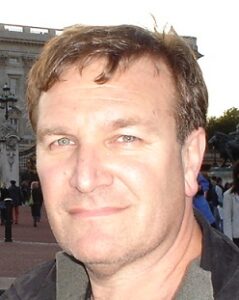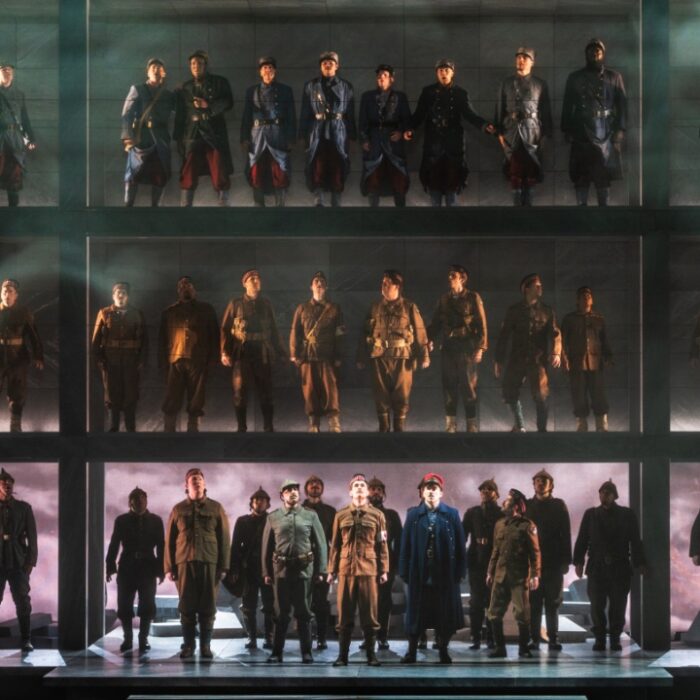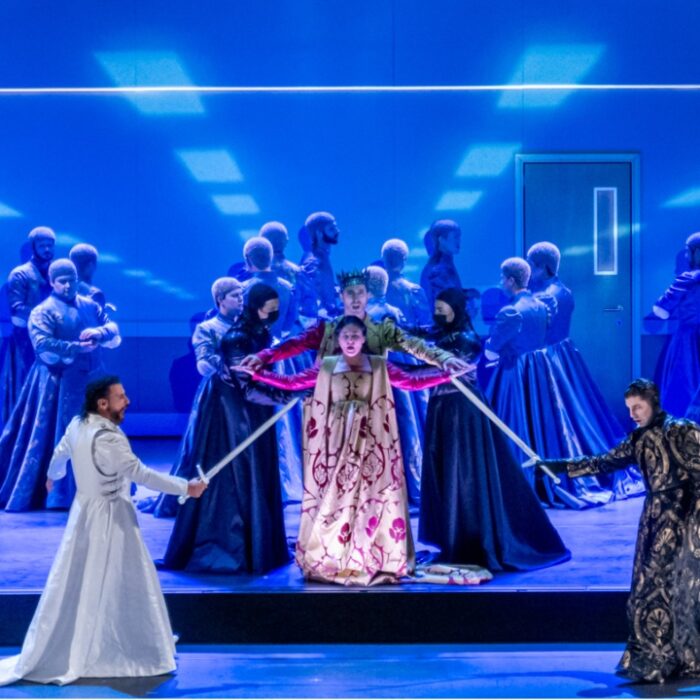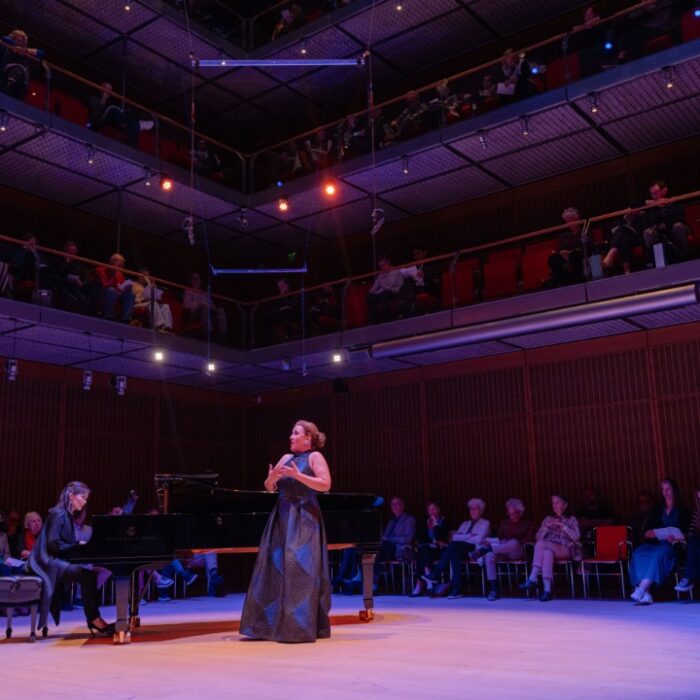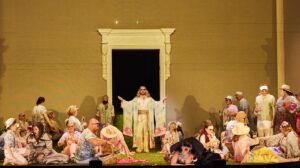
Opera Australia 2024 Review: The Magic Flute
By Gordon Williams(Photo credit: Keith Saunders)
Mozart’s “The Magic Flute” has a bit of everything – part-serious opera, part-singspiel, part-burlesque, part-ritual. Music commentators often seem much exercised with how to categorize it. That thought arose while watching Kate Gaul’s new production of “The Magic Flute” on February 1. This was the third opera in Opera Australia’s 2024 summer season at Sydney Opera House.
Mozart’s music is the first element that grabs an audience’s attention of course and on opening night Austrian-Spanish conductor Teresa Riveiro Böhm got this “Flute” off to a promising start with a finely-detailed overture. Immediately apparent were carefully-constructed musical moments, for example, of those three opening chords that symbolize the deeper meanings of the plot and sweetly melodic interjections coaxed from bassoons and lower strings. This was followed by a clearly-delineated fugue that augured well for the energy of the forthcoming evening.
Once the action began, of course, a new question arose. A theatrical question: how will those disparate elements be melded together?
Various productions have come up with a supervening vision which would house the disparate elements. In Barrie Kosky’s version, premiered at the Komische Oper, Berlin, in 2012 film intertitles accompanied by Mozart keyboard fantasias replaced the dialogue to create the overarching effect of a piano-accompanied 1920s silent film. It was a long way from a traditional presentation.
Gaul’s production combined vernacular informality with moments of high-art seriousness. It was a production that made a virtue of a certain ad hoc quality, effectively re-using Michael Yeargan’s set for a 1989 production of Massenet’s “Werther.” It seemed as though a performance was being put on in an abandoned mansion that was in the process of reverting to a state of nature. The floor of the stage was fake turf. Scenes were changed by one of the three Spirits (Abbey Hammond) pulling string curtains across the stage, the sort of curtains that might divide space in a squat. And the symbolism was simple, devices that a former mansion’s current occupants may have found ‘to hand’ – a red strip-curtain for Tamino’s Act two ordeal by fire; blue for his ordeal by water.
The constructs of the rational world were being given back, it seemed, to the inspirations of nature, an intriguingly paradoxical image for an opera that depicts entertainingly the twin journeys of a man of reason (Prince Tamino, played here by Australian tenor, Michael Smallwood) and a man of appetite (the bird catcher Papageno, played by Australian baritone Ben Mingay) towards enlightenment and/or fulfillment. In the process they win their true loves, Pamina (Australian-Mauritian soprano, Stacey Alleaume) and Papagena (American soprano, Jennifer Black), who themselves will be tested.
Back in 1791, “The Magic Flute” was given in German out in Vienna’s suburbs at librettist Schikaneder’s Theater auf der Wieden. Gaul’s 2024 text was in English, more consistent than the Opera Australia production in 2006 which was in English (for dialogue) and German (for musical numbers), a disjunct combination whose bilingualism may nevertheless have been an apt illustration of the combination of high and popular art that is “The Flute.”
Moreover, the English translation by Gaul and award-winning Australian playwright Michael Gow, who himself produced a version of the “Flute” for OA in 2014, contributed a great part of this production’s charm with delightful rhyming couplets. In Act one, the Queen of the Night’s Ladies (here played by Jane Ede, Indyana Schneider and Ruth Strutt) punish the garrulous Papageno for falsely claiming credit for rescuing Tamino from a dragon, by gagging him. The rhyming couplets managed to honor the opera’s light touch even when conveying serious depth, for example:
If only we could liars silence
We all would then much happier be
Instead of anger hate and violence
We’d live in peace and harmony
The only puzzling notes in the libretto perhaps were references to Clark Gable and Tarzan. Were these meant to be updates? An Opera Australia summer audience these days is as likely to contain students from Shenzhen and Shanghai as people who went to Hoyts matinees last century.
Opera Australia’s cast negotiated the evening’s spectrum from farce to high drama well. Vocally, Australian bass David Parkin as the high priest of the sun Sarastro who will be discovered to be the true anchor to Pamina’s quest provided a solid cantabile grounding to the proceedings. As his offsider, Kanen Breen was a wily, sleazy Monostatos trying to ravish Pamina when the opportunity arose. One of the production’s most humorous moments concerned the enchantment exercised by Papageno when he “disarms” Monostatos’s henchmen by playing his magic bells. Movement Director Andy Dexterity’s choreography managed to convey a sense of Monostatos’s goons (men of the Opera Australia Chorus) forced, embarrassingly, into moves against their bodies as well as their wills.
Australian coloratura Giuseppina Grech made much of her moments as Queen of the Night, the piece’s ostensible villain. Does this role really only consist of three entrances (albeit with two of the most challengingly high-reaching arias in the repertoire)? Grech reliably met the tessitura that Mozart famously specified for this part.
Ben Mingay’s “‘Ow ya goin’?” Australian accent as Papageno (in the dialogue) may have struck some as out-of-keeping with the world of opera but arguably this was the direct communication with the audience that Schikaneder aimed for in his creation of the part. Mingay got laughs entering through the auditorium. Papageno is comic relief, but one of the most genuinely moving details in the whole show was Mingay’s foot tapping along to the music as he sat with legs dangling over a ledge in the Act one duet with Pamina (in German: “Bei Männern”). It said so much about the simple-hearted goodness of this character – and of Mozart’s music.
Australian tenor, Michael Smallwood, brought to Tamino the sort of voice that is congruent with Mozart – limpid, clear, bell-like – apparent from the opening “Save me, save me” (from the dragon) but revealed to good effect in his extolling of Pamina’s portrait (in German: “Dies Bildnis”), shown him to spur him on a quest for Pamina.
Australian-Mauritian soprano Stacey Alleaume provided the evening’s most genuinely moving musical moment in her Act two aria, “Ach, ich fühl’s, ” which became “Now I know that love can vanish/ Now I know that love brings pain,” when she doesn’t realize Tamino is actually under instructions not to talk to her. Perhaps, by a smidge, the rough theater milieu of this production made the emotional depth of some moments harder to achieve, but in this moment the audience paused to genuinely consider Alleaume’s song.
Apparently, Schikaneder’s theater out in the Vienna suburbs was not the “wooden shack” that Ignaz von Seyfried, its musical director from 1798-1801, once made it out to be. But it was also not the palatial sort of venue associated with the 18th century theaters which normally heard opera. This production might have conveyed what it would have been like hearing this work for the first time in 1791 as an entertainment, albeit studded with some exceptional music, in Schikaneder’s suburban theater.
